How to Paint Cardboard – Step by Step Guide in 2024
Painting cardboard is not as easy as most people think. Unlike many other metals and elements, this cardboard does not have a smooth surface. Instead, it has a porous surface, due to which its adhesion power for paint is meager. Hence how to paint cardboard is not easy to know especially when you are unaware of the paint type that can work best for this material.
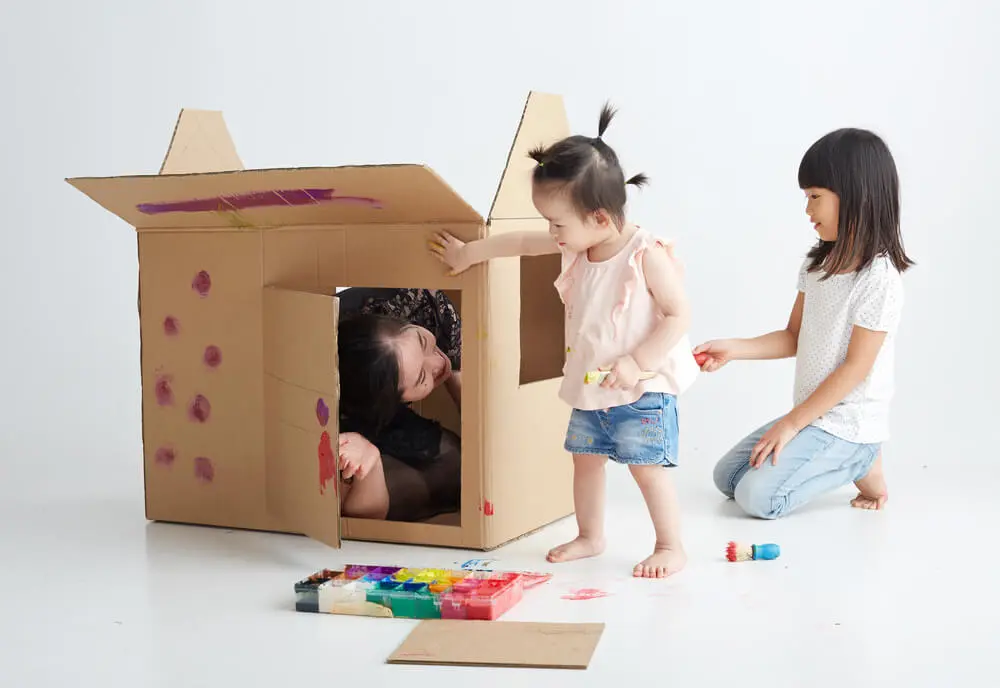
So, if you are the one who wants to know about painting on cardboard, here is a complete detail with steps. I also enlisted the best spray paint for cardboard which can help you to eliminate your efforts to find the perfect color.
How to Paint Cardboard? Explanation
Painting cardboard has become famous in recent years due to its increasing demand in the market for painting and many other tasks. Here are some reasons why it’s becoming popular:
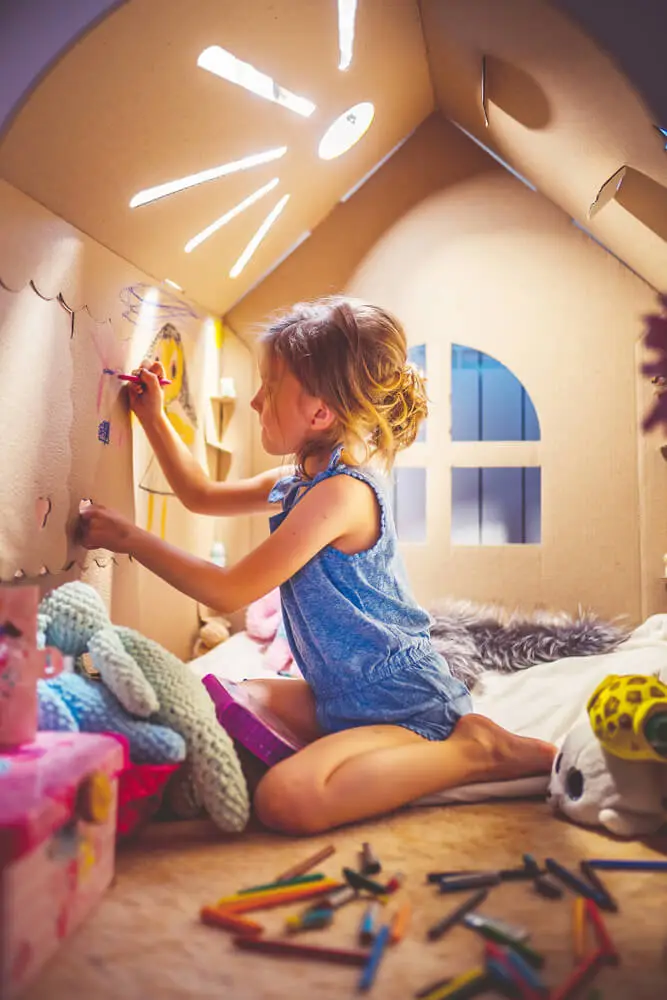
Types of Paints Useful for Cardboard
It is not easy to find the best paint to use on cardboard just by looking at the durability or color of the paint. There are many factors that one should consider while buying painting products for cardboard. Oil-based paints, spray paints, acrylic paints, and pastel paints are helpful for cardboard products.
In my experience, Paint type is not enough to consider, cardboard type is also essential for the perfect painting results, and most people don’t think it. Corrugated cardboard needs some specific care rather than standard cardboard because of the complexities that it can create while painting.
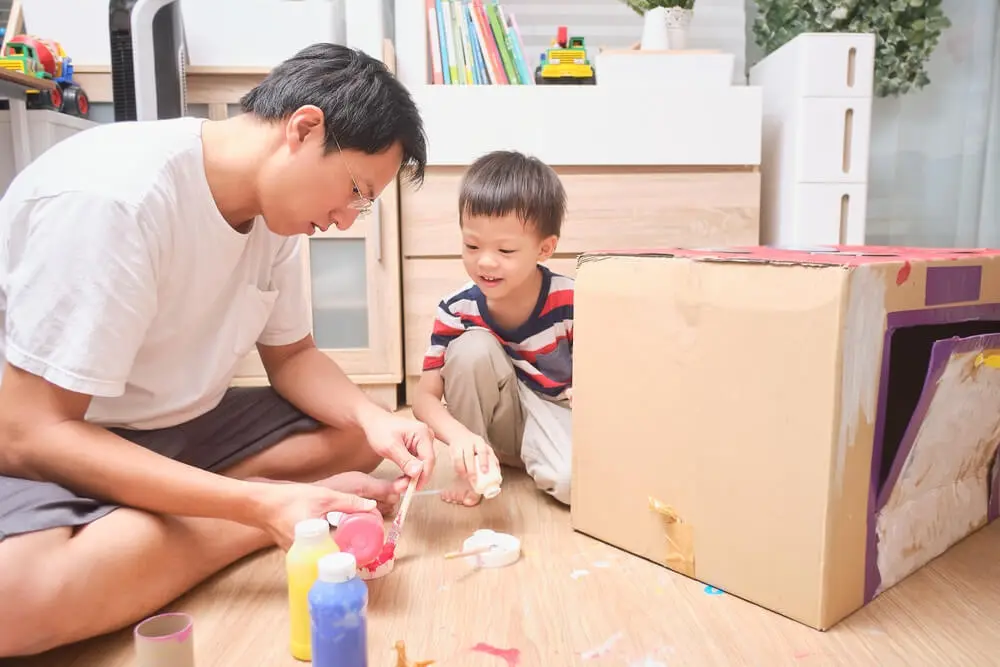
The best way to avoid any problems during the painting is to use the best primer according to the quality and nature of the paint. Primer is necessary when you need the perfect look and glossy results on the cardboard surface. Primer also increases the durability of the final painting product. The primer should be applied before the paint, and make sure to consider its type is matched to the paint type you will use.
Primer is available at any nearest marketplace, so you don’t need to worry about its availability.
Paint Cardboard without Wrapping
Cardboard is easy to wrap, even by the little movement you make while applying the paint with a hard object. So, it’s essential to know how to paint cardboard without wrapping. The best way to do so is by applying a primer. A primer works as a fixer against the wrapping process and makes the surface smooth which has a lot of adhesion ability for the paint.
Later during the color, you don’t need to apply extra force or effort to paint a cardboard surface which ultimately protects it from wrapping. Using primer has an additional advantage which makes the overall products durable.
Priming the Cardboard for Painting
As I mentioned above it’s essential to prime the surface for top-quality results without painting without wrapping. Selecting the prime and following the next step is necessary. Priming the texture of cardboard is more critical and complex than painting it later for high-quality results.
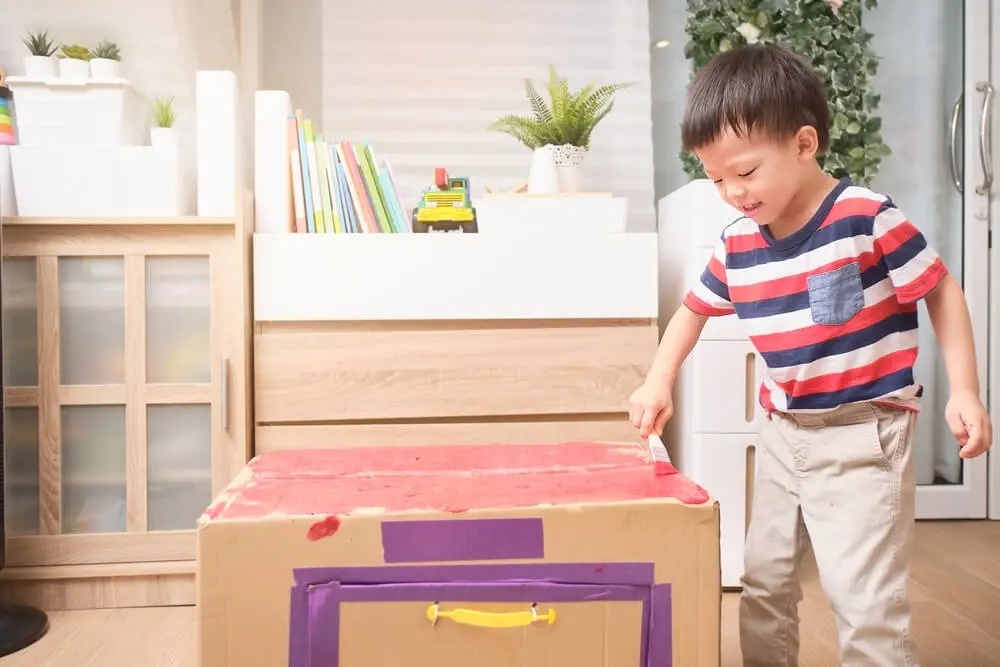
Using Gesso primer is an ideal choice which is easy to implement and affordable when it comes to knowing about prices. Gesso’s primary function is to make the surface pure and clear for the painting. It turns the character into a whitish look and gives it a smooth look and nature. Due to its slippery nature, the cardboard’s adhesion power becomes high, so it’s easy to apply paint.
Required material for priming the cardboard
Now are the steps to prime the surface using Gesso:
Step 1: Applying Cardboard on Gesso
Applying the Gesso on a cardboard surface with a paintbrush is the first process. Put the gesso primer in a large beaker if you buy it in the form of bottles, and apply a layer on cardboard with the help of a paintbrush.
In the very first attempt, try to put a thin layer and don’t go for a thick layer on the surface. This process is straightforward; just make sure to implement the brush in vertical strokes.
Step 2: Apply the Second Coat of Primer
Once the first coat of primer is dried thoroughly, apply a second coat of the primer. You can wait for 2 hours for the drying of the very first coat of primer. Apply the second layer of primer just as you have applied the first one and wait for it to dry. See if the surface becomes white.
If the cardboard surface is still brown in some areas, you can apply a third layer of primer.
Step 3: Using Sandpaper
Gesso can create a harsh and brutal appearance on cardboard which is ideal for some painting projects. If you don’t want to get this appearance, I recommend applying sandpaper to eliminate the hardness of the surface.
Different sandpapers are available in the market, and you can use them according to your needs, using 500-grit sandpaper is ideal, however.
Note: using the primer on cardboard is essential. Here is the video to watch the difference of painting results on primed and unprimed cardboard.How to Paint Cardboard with Acrylic Paint- Detailed Process
Required Material
- Acrylic Paint
- Paintbrush
- A rough cloth
- Primer
Step 1: Preparing the Surface for Paint
Preparing the surface for painting is essential, as applying paint directly can cause some severe issues. Take a rough, smooth cloth piece and clean the cardboard surface to remove dust and dirt particles.
Now similarly apply the primer as I mentioned above. 2 layers of the primer are enough, and if you feel the color issues, you can implement a third layer of primer.
Step 2: Applying Paint on Brush
Most people directly apply paint on the cardboard and then make it spread with the help of a brush or a cloth. It is not a good way at all and can create some issues with the surface.
To apply a regular and attractive coat of acrylic paint, it’s essential to implement the color on the brush and then on the cardboard surface. Using paint at the meeting gives an idea about how much paint you need to put on the surface. Additionally, it’s helpful to avoid paint spots created on the surface when a very high or low amount of paint is applied.
Step 3: Painting the Cardboard Surface
Acrylic paint on cardboard gives high-quality and shiny results when you want long-lasting results. Apply a thin coat of acrylic paint and allow it to dry. You can wait for 24 hours before applying the second coat of paint. It is because it’s essential to completely dry for the first layer before using the next layer.
After the first layer is dried, apply a second coat of the paint with the help of a brush. If you get the desired results, allow the paint to dry, and you can use the product after 24 hours.
Still, if you face issues like uneven paint surfaces, I recommend applying a third layer of paint for desirable results.
Video: Acrylic Paint on Cardboard
Best Acrylic Paint for Cardboard
Acrylic paints are ideal for cardboard because they consistently stick to the material for a long time. These are easy to use everywhere apart from the metals and cardboard. Here are some acrylic paints for cardboard that are readily available in the market and are top-rated among professionals:
1. Mont Marte Signature Acrylic Paint Set
It comes with a set where 26 colors are available. This acrylic paint is helpful for canvas, packaging, metals, and wood or plastic products. This paint is useful for each type of surface without worrying about the glossy and durability of the character.
The paint is highly resistant to UV rays and external chemicals. Moreover, adverse environmental conditions don’t affect it a lot. Its drying is just ideal and fast enough. In short, if you need paint for cardboard that is easy to apply and dry quickly, this acrylic paint is perfect.
2. ARTIST Acrylic Paint Set
It is another famous and ideal acrylic paint for cardboard which has a lot of advantages to implement because of fast drying and a shiny finish at the end. It comes in 24 different colors so you can paint the cardboard with different colors and layers.
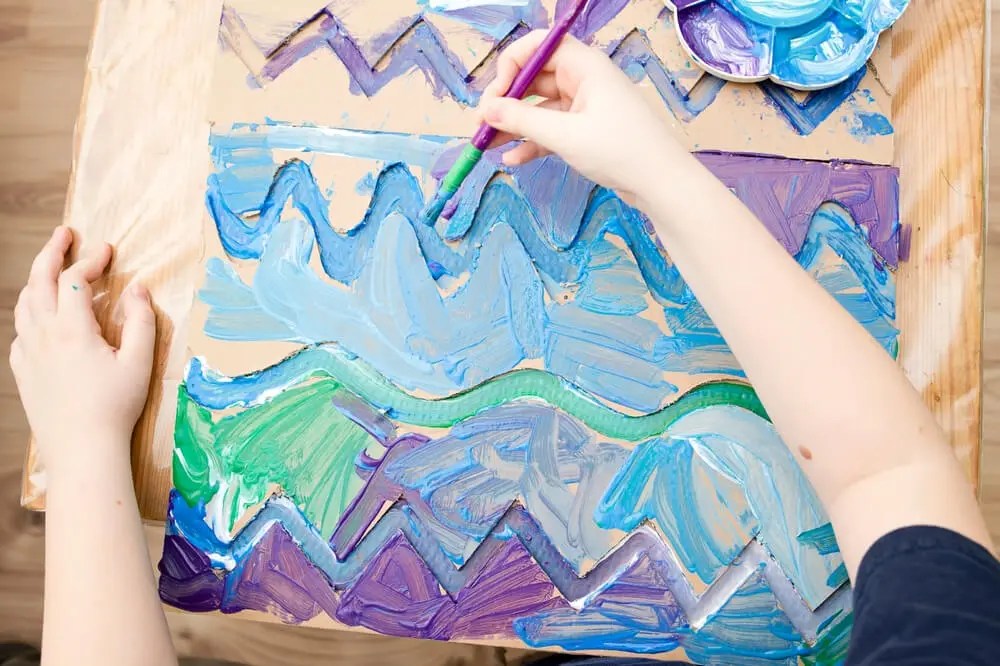
This paint is helpful for art techniques in different places, including packaging and art products. Due to its resistant power against UV rays, sunlight, and rain, it’s useful for exterior decorations and external surfaces.
How to Spray Paint a Cardboard
Spray paint is also good to use on cardboard because of its durability, power, and other features which it owns. This paint is valuable enough to protect the area from the weather and rainy conditions. Additionally, it’s resistive against UV and sun rays, another feature that makes professional painters consider buying this paint.
Required Material
- Spray paint
- Paintbrush
- Gloves
- Newspaper
Step 1: Preparing the Surface Area
Preparing the surface area is more important here because it’s not easy to wash off or remove the spray paint compared to acrylic paint. It’s not much water-soluble comparatively, so one should care about the safety precautions. Wear hand gloves and complete clothes before starting the procedure.
Now wash off the surface or clean it with a rough cotton cloth or a good sweeper. It’s essential to prepare the cover to avoid hurdles to get a shiny finish. Now apply a primer layer to the surface to make it smooth and ready for the paint.
Step 2: Shaking the Spray Paint
Most people miss this step intentionally or intentionally, and they face many issues later. Shaking the paint is essential to get an even and regular paint surface.

Shaking the paint helps it to mix all the ingredients in color, making it ideal for cardboard. If you are using it without shaking, then there are chances that the surface will become uneven and get spots if the paint is thick on any of the little parts.
Step 3: Applying the Paint
It is the most critical step and differs from applying acrylic paint on the surface. After shaking the spray bottle, now allow the color to stand inside it for 5 minutes.
Start applying the paint by standing away from the surface in a zig-zag pattern. Hold the spray bottle in the parallel position of the cardboard.
Apply the paint to the cardboard surface similarly until you are sure that you are successful in gaining an even painted surface.
Now allow the paint to dry for hours and apply a second layer of paint if necessary. Spray paints come in different colors and categories; hence, you can change the color for the second coat to get ideal results.
Note: If you own a rough piece of cardboard, then it’s ideal for practicing spray paint on it with different colors. After you get enough ideas, paint the cardboard just like a professional.Video: Spray Paint the Cardboard
Best Spray Paint for Cardboard
Spray paints are helpful as they take less time to dry and don’t need an additional item to paint any surface. Here are some of the top-rated spray paint products for the cardboard which our professionals recommend:
1. Krylon Glitter Spray Paint
Krylon is affordable to buy and easy to use as compared to many paints available in the market. Due to its features, it’s ideal for newbies as it’s somehow easy to remove from clothes and cardboard surfaces.
It comes in different colors, including gold and brown, which offer a glitter-like shiny surface. The surfaces you can use this paint are metals, wood, cardboard, and vinyl.
2. Rust-Oleum 249130 Spray Paint
Rust-Oleum 249130 is an ideal spray paint and is well-reputed worldwide. I recommend it for professional and experienced painters due to its excellent features.
This paint is dead easy to apply on cardboard and all other surfaces. People love to use this paint because of the quick drying process, as it takes only 30 minutes to dry. Additionally, it does not create surface fading issues due to its resistance power against other paints, UV rays, and rainy weather conditions. This paint has more pros and fewer cons.
Cardboard Spray Painting Tips/Ideas
After reading the above steps and guidelines, it’s easy to paint cardboard for everyone. Still, here are some tips that are helpful to save your time, money, and energy while painting cardboard:
What to do if Cardboard is Wrapped During the Paint
Material Required
- Spray bottle
- Heavy objects, including books, copies, or any
- Water
Step 1: Allow the Cardboard to Dry
The first and crucial step to starting the process is to allow the cardboard to dry completely. Once you get the wraps on the surface, don’t worry and keep calm.
Step 2: Spritz with Water
Now again, rehydrate the surface where you want to remove wraps. Don’t use much water and apply as you are wetting the surface. Don’t pour water or dip the whole cardboard in water.
Step 3: Load the Surface
Now apply the books, copies, or layers of plywood just like the bookshelf. Keep them on one another step by step and then leave it for some hours. In this way, all the water you applied in the second step is removed; hence, the wraps are eliminated.
The books or plywood absorb as much water as is available on the surface without any issues with the cardboard surface.
Frequently Asked Questions
Wrapping Up- How to Paint Cardboard
Hence, painting cardboard is accessible only if you follow some steps and guides. Always make sure to apply the primer before applying the paint on cardboard. Don’t allow much water to stand on the surface while preparing it; allow it to dry completely. Avoid painting the cardboard where much moisture is present.
For more information on painting and tips, keep reading our latest blogs here!

